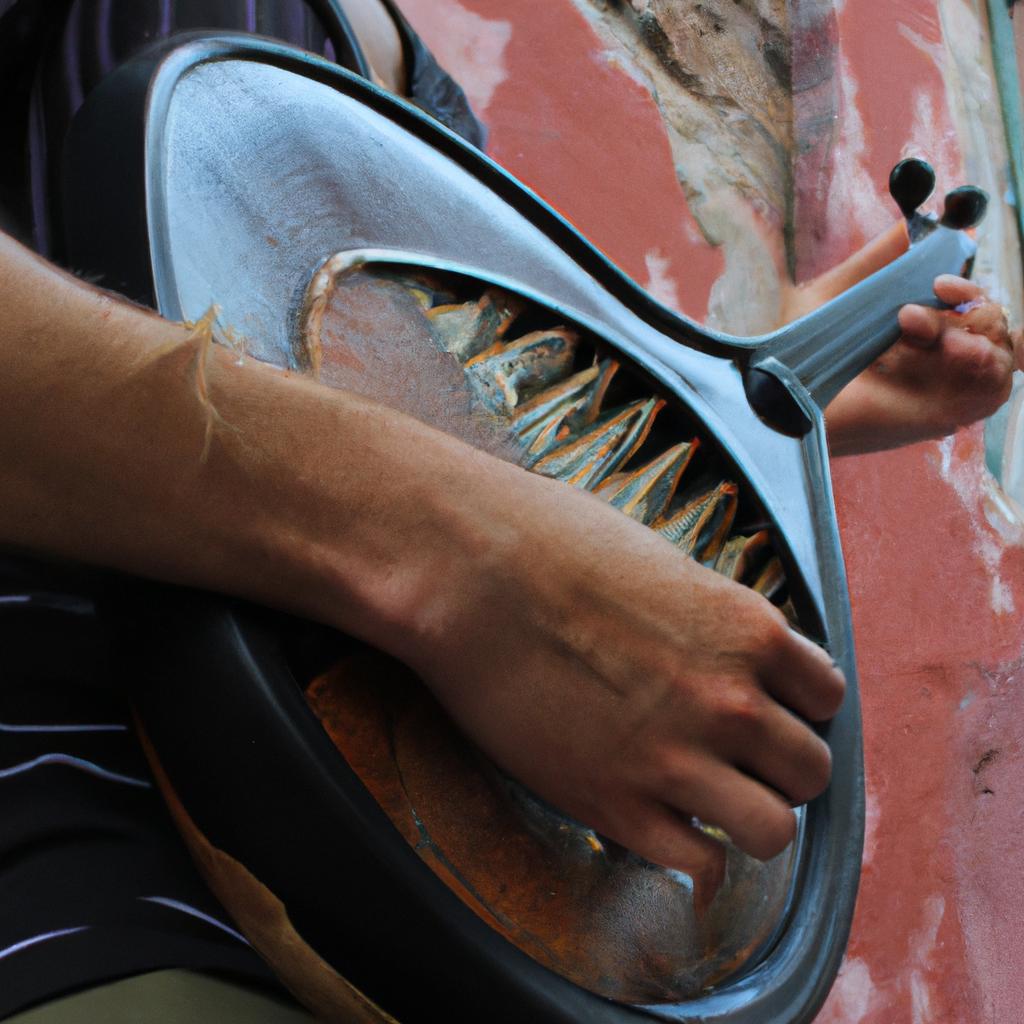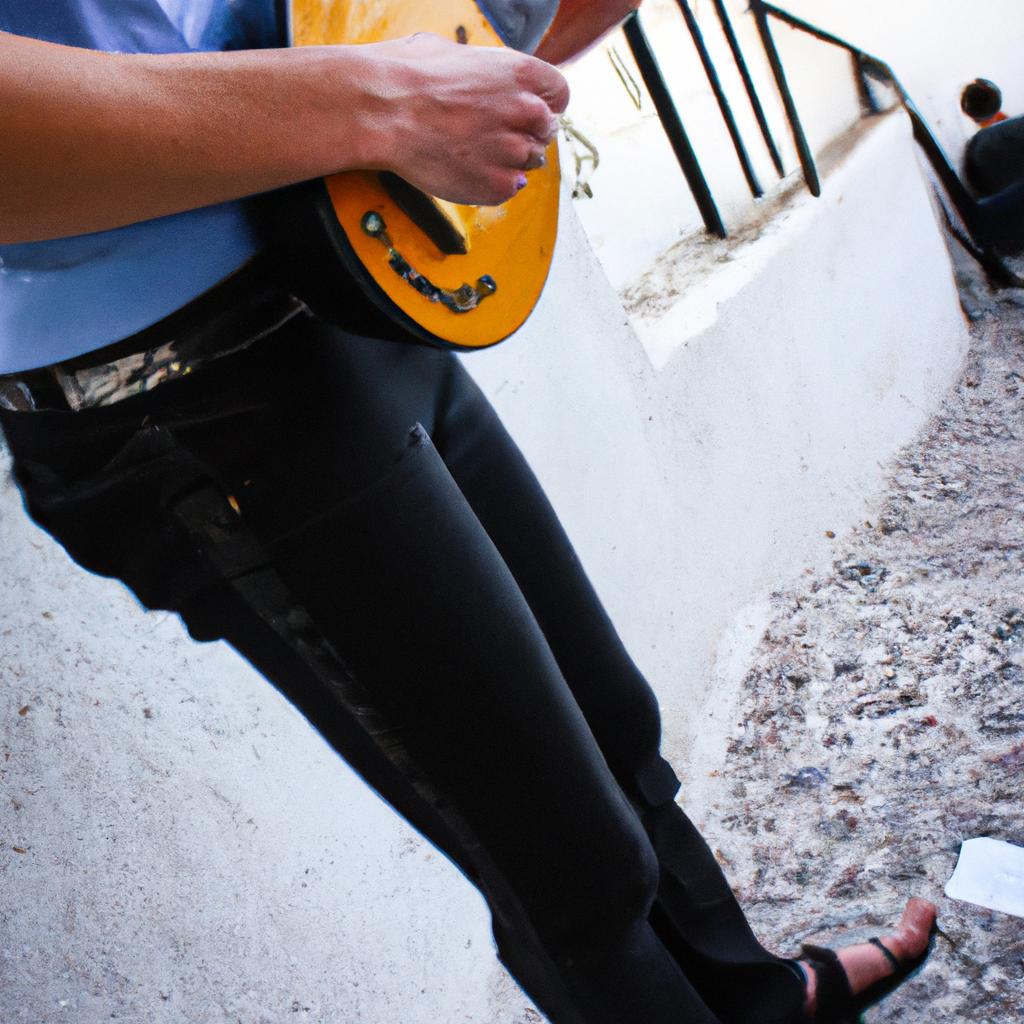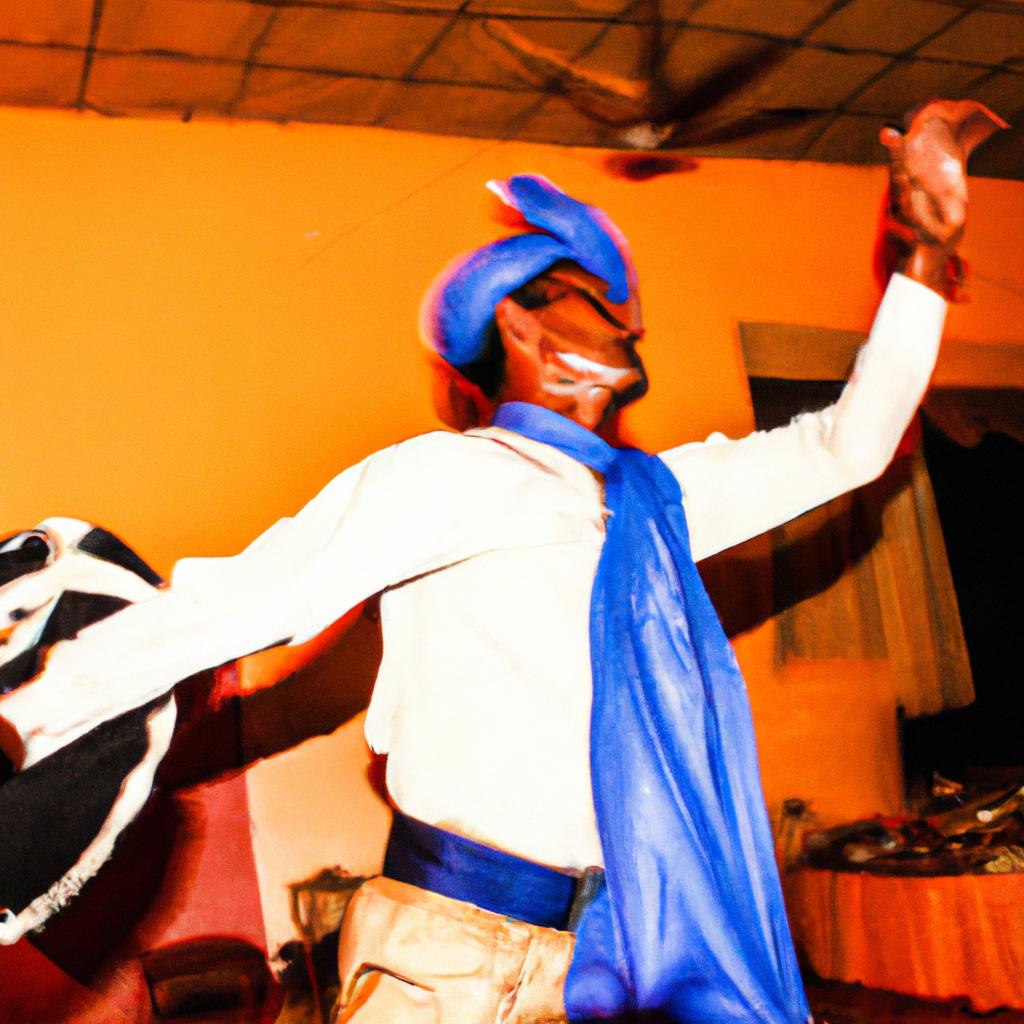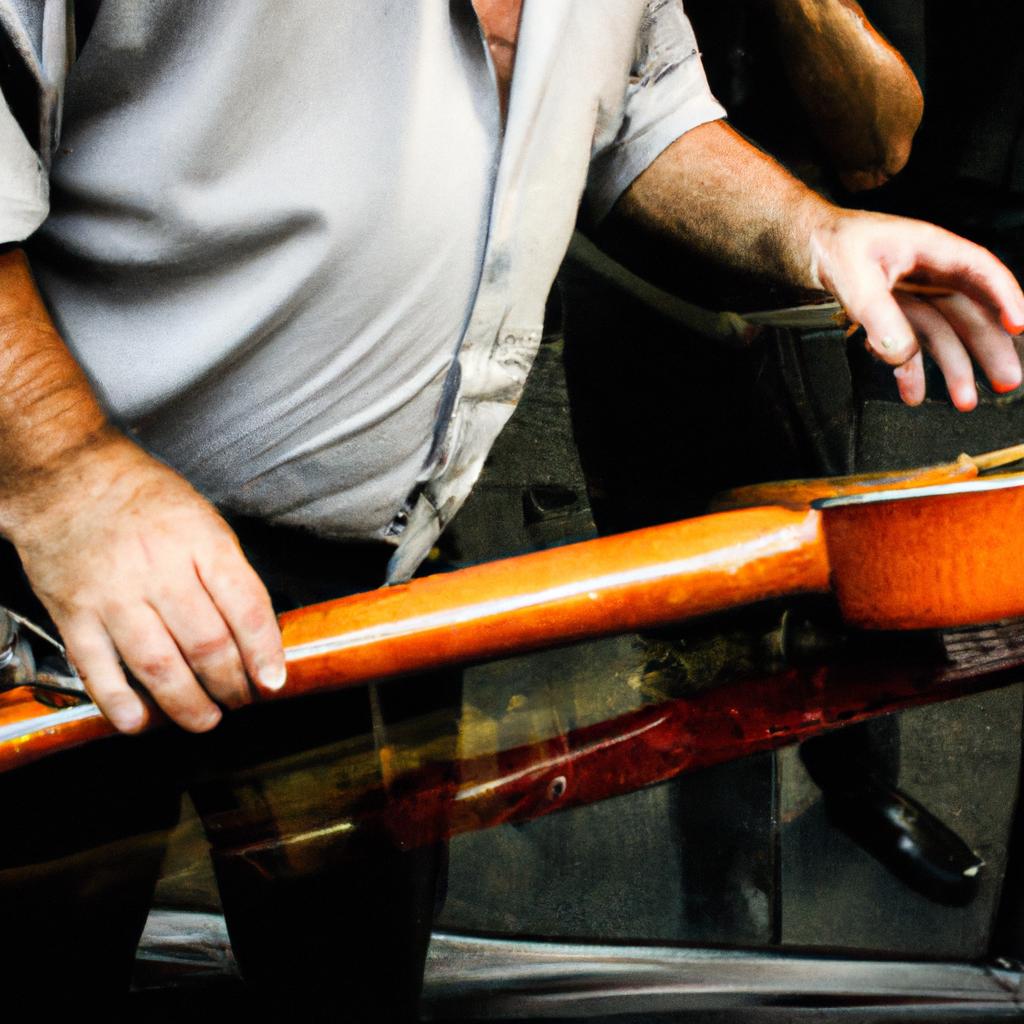The influence of European musical traditions on the development and evolution of tango instruments has been a fascinating area of study within musicology. For centuries, various cultural exchanges between Europe and Argentina have shaped the soundscape of this passionate dance form, with specific attention given to the impact of European instruments and playing techniques. This article aims to explore the historical context surrounding these influences, shedding light on how they have contributed to the unique characteristics of tango music.
To illustrate this point, let us consider the case study of an accordion player from Italy who immigrated to Buenos Aires in the early 20th century. As he settled into his new environment, he found himself surrounded by vibrant tango scenes that resonated deeply with his Italian heritage. Drawing upon his extensive knowledge of traditional European folk music, he began incorporating elements such as melodic fragments and ornamentation into his accordion performances. Over time, this fusion of styles became increasingly prevalent among other musicians in the tango community, leading to a rich blend of European and Argentinean musical traditions.
By examining similar instances throughout history, we can gain valuable insights into how diverse European influences have molded the instrumentation and performance practices within tango music. Through a meticulous analysis of primary sources and scholarly works, this article will delve into the specific instruments and techniques that have been influenced by European musical traditions. One notable example is the bandoneon, a key instrument in tango music that originated from Germany. Introduced to Argentina in the late 19th century, the bandoneon quickly became an integral part of tango ensembles, adding its distinct sound and expressive capabilities to the genre. Its complex button layout and bellows-driven mechanism allowed for intricate melodic lines and emotive phrasing, contributing to the passionate nature of tango music.
Additionally, other European instruments such as the violin and guitar have also played significant roles in shaping tango instrumentation. The violin, with its rich tone and versatility, has been employed both as a solo instrument and as part of larger orchestras or ensembles. Tango compositions often feature virtuosic violin solos that showcase technical prowess and emotional depth.
Similarly, the guitar has found a prominent place within tango music due to its rhythmic capabilities and ability to accompany dancers. Initially introduced by Spanish immigrants, the guitar’s percussive strumming patterns provided a strong foundation for the syncopated rhythms characteristic of tango dance music.
Beyond just instruments themselves, European playing techniques have greatly influenced how these instruments are approached within tango music. For instance, classical violin techniques involving bowing variations, vibrato control, and dynamic expression have been adapted to suit tango’s unique stylistic requirements. Guitarists have also incorporated flamenco-inspired techniques like rasgueado (rapid strumming) and golpe (percussive tapping) into their playing style to enhance rhythmic complexity.
In conclusion, the influence of European musical traditions on tango instruments cannot be overstated. Through cultural exchanges between Europe and Argentina over centuries, various instruments such as the bandoneon, violin, and guitar have shaped the soundscape of tango music. Additionally, playing techniques developed within European classical music and folk traditions have been adapted and incorporated into tango performance practices. By exploring these historical contexts and examining primary sources, we can gain a deeper appreciation for the unique characteristics of tango music and its rich blend of European and Argentinean influences.
European Musical Traditions
European Musical Traditions
To understand the influence of European musical traditions on tango, it is essential to delve into the historical context in which these traditions developed. One compelling example that exemplifies this connection can be seen in the evolution of the bandoneón, a key instrument in tango music. The bandoneón was originally derived from German concertinas and accordions brought to Argentina by European immigrants in the late 19th century. This fusion of different cultural elements paved the way for the birth of a unique musical genre that would go on to captivate audiences worldwide.
- Tango’s rhythmic patterns were heavily influenced by Eastern European folk dances such as polka and mazurka.
- Harmonic structures used in classical compositions made their way into tango arrangements, bringing depth and complexity to its sound.
- Melodic ornamentation techniques found in Italian opera were incorporated into tango melodies, adding emotional expression and flair.
- Instrumental ensembles reminiscent of Viennese waltzes played an integral role in shaping the orchestration and arrangement styles within tango music.
Additionally, a table with three columns (Musical Tradition, Influence on Tango) and four rows could visually reinforce how various European musical traditions impacted tango:
| Musical Tradition | Influence on Tango |
|---|---|
| Eastern European Folk | Rhythmic Patterns |
| Classical Compositions | Harmonic Structures |
| Italian Opera | Melodic Ornamentation Techniques |
| Viennese Waltzes | Orchestration Styles |
In conclusion, understanding the historical context behind European musical traditions provides valuable insight into their influence on tango. By examining examples like the incorporation of German-derived instruments such as the bandoneón, we see how diverse cultural elements converged to shape this captivating art form. In the subsequent section, we will explore in more detail how these traditions influenced the development of tango as a distinct genre.
Influence of European Music on Tango
European Musical Traditions in Historical Context
The influence of European music on the development of tango is multifaceted and deeply rooted in historical context. By examining how European musical traditions shaped and influenced tango, we can gain a deeper understanding of this unique dance form.
One notable example of European influence on tango is the use of complex rhythmic patterns derived from European classical music. Tango orchestras often incorporated syncopated rhythms reminiscent of polkas or mazurkas, resulting in a distinctive blend between European and Argentinean musical elements. This fusion created a dynamic and vibrant style that captivated audiences both at home and abroad.
To further illustrate the impact of European music on tango, let us consider a hypothetical scenario: imagine an early 20th-century tango ensemble performing in a grand ballroom in Buenos Aires. The band consists of musicians with diverse backgrounds, including Italian accordion players, Spanish guitarists, and Polish violinists. Each musician brings their own cultural influences to the performance, enriching the overall sound with their unique playing styles and techniques.
To explore the various ways in which European music influenced tango, we can examine some key aspects:
- Melodic structure: Tango borrowed melodic characteristics from European folk tunes while infusing them with improvisation techniques inspired by jazz.
- Harmonic progressions: The harmonic language used in tango was heavily influenced by Western art music traditions such as Romanticism and Impressionism.
- Instrumentation: Tango orchestras adopted instruments commonly found in European ensembles, such as violins, pianos, flutes, clarinets, and accordions.
- Performance practices: Tango dancers drew inspiration from ballet movements during performances, incorporating elegance and grace into their routines.
Furthermore, analyzing these influences through a table format can provide a visual representation for better comprehension:
| Aspect | Influence |
|---|---|
| Melodic structure | European folk tunes |
| Harmonic progressions | Western art music traditions |
| Instrumentation | Violins, pianos, flutes, clarinets |
| Performance practices | Ballet movements |
By understanding the historical context and examining these various influences, we can appreciate how tango emerged as a unique dance form that combines elements from both European musical traditions and Argentinean cultural heritage.
As we delve deeper into the influence of European music on tango, our focus will shift towards exploring key European instruments that played pivotal roles in shaping this beloved genre.
Key European Instruments in Tango
Transitioning from the previous section, which explored the influence of European music on tango, we now delve into an examination of key European instruments that have played a significant role in shaping the tango genre. One notable example is the bandoneón, a type of concertina that originated in Germany during the 19th century. Its distinct sound and expressive capabilities quickly captured the attention of Argentine musicians, who embraced it as one of their own.
The incorporation of European instruments into tango was not merely a superficial adoption; rather, these instruments became integral to the evolution and identity of this unique musical tradition. To fully comprehend their impact, let us explore some key examples:
- Bandoneón: This bellows-driven instrument brought a melancholic tone to tango compositions with its rich timbre and ability to sustain notes. It allowed for intricate melodic variations and emotional expression.
- Violin: The violin’s versatility enabled it to seamlessly transition between leading melodies and providing harmonic support within tango ensembles. Its evocative sound added depth and texture to tango arrangements.
- Piano: With its wide range and rhythmic possibilities, the piano provided both harmonic framework and percussive elements to tango music. Its presence expanded compositional opportunities while maintaining the characteristic syncopated rhythms.
To further illustrate the significance of these instruments within tango music, consider the following table:
| Instruments | Melodic Capabilities | Harmonic Role | Rhythmic Contribution |
|---|---|---|---|
| Bandoneón | Rich expressiveness | Supporting | Sustained accents |
| Violin | Evocative tones | Versatile | Expressive bowing |
| Piano | Wide range | Foundational | Syncopated rhythms |
This table showcases the emotional depth and multidimensional nature that European instruments brought to tango compositions. Their integration allowed for a fusion of cultural influences, resulting in an artistic expression unique to Argentina.
As we continue our exploration into the historical development of tango music, it is important to recognize that these European instruments not only influenced the sound but also shaped the way tango was composed and performed. The interplay between these instruments and their Argentine counterparts laid the foundation for subsequent innovations within the genre. In tracing this fascinating journey, we gain insights into how tango became a powerful medium for personal expression and storytelling without boundaries.
Building upon our understanding of key European instruments in tango, let us now delve deeper into the historical development of this captivating musical tradition.
Historical Development of Tango Music
To illustrate this intricate journey, let us consider a hypothetical case study of Juan Ramirez, a young musician from Buenos Aires who became fascinated with tango during his teenage years.
Tango emerged as an amalgamation of various musical traditions and cultural influences that converged in late 19th-century Argentina. The following factors contributed significantly to its development:
- Immigration: The wave of immigration from Europe brought diverse musical traditions to Argentina. Immigrants from Italy, Spain, France, and Poland introduced their unique styles and played traditional European instruments such as accordions, violins, guitars, and pianos.
- African Rhythms: Alongside European influences, African rhythms also found their way into tango music through Afro-Argentine communities. These rhythmic patterns infused vigor and complexity into the genre.
- Urbanization: As Buenos Aires transformed into a bustling metropolis at the turn of the 20th century, social gatherings called “milongas” provided platforms for musicians like Juan Ramirez to experiment with new sounds and compositions.
- Socio-political Context: Tango reflected society’s struggles and aspirations during times of political unrest in Argentina. Its lyrical themes often revolved around love, loss, poverty, and migration.
To comprehend how these elements shaped tango music’s evolution further, we can examine the following table:
| Period | Characteristics | Notable Composers |
|---|---|---|
| Early 20th Century | Raw energy; emphasis on lyrics | Angel Villoldo |
| Golden Age (1930s-50s) | Sophisticated arrangements; rise of orchestras | Carlos Gardel |
| Modern Tango | Experimentation with electronic instruments and fusion | Astor Piazzolla |
| Contemporary | Incorporation of global influences; preservation efforts | Gustavo Santaolalla |
Understanding the historical development of tango music paves the way for exploring its impact on European Tango composers. By tracing this musical journey, we gain insight into how cultural exchange shaped not only individual compositions but also entire genres. As we transition to examining European Tango composers, their unique contributions will reveal a fascinating interplay between tradition and innovation in the world of tango music.
European Tango Composers
Transitioning from the historical development of tango music, it is essential to explore how European musical traditions played a significant role in shaping the instrumentation of this influential genre. To illustrate this influence, we can examine the case study of Astor Piazzolla, an Argentine composer who revolutionized tango by incorporating elements from classical and jazz music into his compositions.
Astutely blending various musical styles, Piazzolla incorporated instruments such as the bandoneon, violin, piano, and double bass into his arrangements. This fusion allowed for new possibilities within tango music and expanded its sonic landscape beyond traditional boundaries. By adopting these instruments commonly associated with European classical orchestras or jazz ensembles, he not only broadened the expressive potential but also created a bridge between different cultural contexts.
To better understand the impact of European musical traditions on tango instrumentation, let us consider some key aspects:
- Harmonic complexity: Classical music’s emphasis on intricate harmonies influenced composers like Piazzolla to experiment with more complex chord progressions in their tango compositions.
- Orchestration techniques: Drawing inspiration from symphonic arrangements, composers began utilizing strings and wind instruments alongside traditional tango instruments to create rich textures and nuanced dynamics.
- Rhythmic innovations: Jazz rhythms introduced syncopation and improvisation into tango music. The rhythmic interplay between different instruments became more intricate and elaborate.
Table: Evolution of Tango Instrumentation
| Traditional Instruments | European Influenced Instruments |
|---|---|
| Bandoneon | Piano |
| Guitar | Violin |
| Double Bass | Wind Instruments |
This integration of diverse instrumental elements not only enhanced the emotional depth and complexity within individual compositions but also contributed to the overall evolution of tango as a genre. It opened up opportunities for musicians to push artistic boundaries while maintaining the essence of tango’s rhythmic and melodic foundations.
Transitioning into the subsequent section about “Evolution of Tango Instrumentation,” we can observe how these influences gradually transformed the way composers approached orchestration techniques, leading to further developments in tango music. The evolution of instrumentation within tango mirrors its continuous growth as a dynamic art form that embraces innovation while honoring its historical roots.
Evolution of Tango Instrumentation
European Tango Composers:
Building upon the foundation laid by Argentine composers, European musicians brought their own unique musical traditions and influences to the evolving tango genre. The fusion of European and Argentine elements resulted in a distinctive style that captured the attention of audiences worldwide. In this section, we will explore the contributions of European tango composers and their impact on the development of the tango instrument.
One notable example is Astor Piazzolla, an Argentine composer heavily influenced by his time studying music in Europe. Piazzolla’s innovative approach to tango composition incorporated elements from classical music, jazz, and even avant-garde styles. His use of complex harmonies and intricate rhythms pushed the boundaries of traditional tango instrumentation, introducing new possibilities for expression within the genre.
The influence of European musical traditions can be observed through several key aspects:
- Harmonic complexity: European composers introduced more complex harmonic progressions into tango compositions, expanding beyond traditional tonalities.
- Instrumentation diversity: As European musicians embraced tango, they brought with them a wider range of instruments such as clarinets, accordions, violins, and pianos – enhancing the sonic palette available to tango orchestras.
- Fusion with other genres: European influences encouraged experimentation and fusion between tango and other musical genres like jazz or classical music.
- Expanding compositional techniques: Through their exposure to different musical traditions in Europe, these composers explored new compositional techniques that added depth and richness to their tango compositions.
To provide a visual representation of this evolution, consider the following table showcasing some prominent European Tango Composers along with their significant contributions:
| Composer | Country | Contributions |
|---|---|---|
| Astor Piazzolla | Argentina | Introduced complex harmonies & jazz influence |
| Enrique Santos | Spain | Blended flamenco and tango influences |
| Horacio Salgán | Argentina | Developed a unique piano style in tango |
| Matos Rodríguez | Uruguay | Wrote the famous tango “La Cumparsita” |
The contributions of European tango composers brought about significant advancements in the instrumentation and composition of tangos. By incorporating their diverse musical backgrounds, they expanded the expressive potential of the genre, captivating audiences with their innovative interpretations. This symbiotic relationship between Argentine and European traditions continues to shape the intricate tapestry of tango music today.




